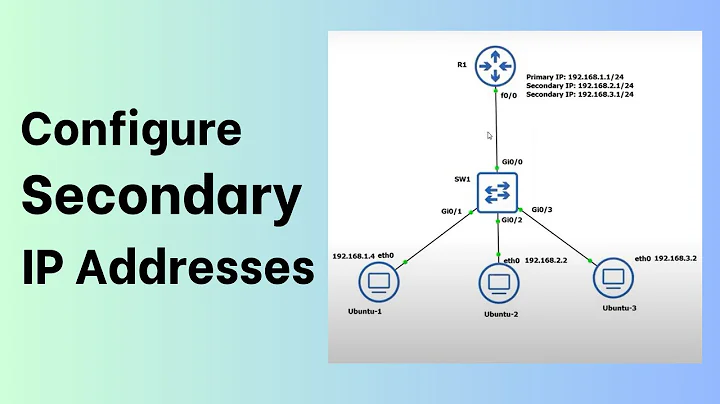How can I display the IP address of an interface?
Solution 1
Try this (Linux)
/sbin/ifconfig eth1 | grep 'inet addr:' | cut -d: -f2| cut -d' ' -f1
or this (Linux)
/sbin/ifconfig eth0 | awk -F ' *|:' '/inet addr/{print $4}'
or this (*BSD)
ifconfig bge0 | grep 'inet' | cut -d' ' -f2
or this (Solaris 10)
ifconfig e1000g0 | awk '/inet / {print $6}'
Obviously change the interface name to match the one you want to get the information from.
Solution 2
As @Manuel mentioned, ifconfig is out of date, and ip is the recommended approach going forward.
ip -f inet addr show eth1
and to use @bleater's sed or @Jason H.'s awk to filter the output (depending on if you want the mask)
ip -f inet addr show eth1 | sed -En -e 's/.*inet ([0-9.]+).*/\1/p'
ip -f inet addr show eth1 | awk '/inet / {print $2}'
Solution 3
On a Linux system:
hostname --all-ip-addresses
will give you only the IP address.
On a Solaris system use:
ifconfig e1000g0 | awk '/inet / {print $2}'
Solution 4
A better way: get ip adress from command "ip", because "ifconfig" is out of date. Otherwise you will get a problem on using "ifconfig", because the output of ifconfig is language dependend.
I use this command to get all IPs (IPv4):
ip addr show | grep -o "inet [0-9]*\.[0-9]*\.[0-9]*\.[0-9]*" | grep -o "[0-9]*\.[0-9]*\.[0-9]*\.[0-9]*"
Solution 5
To obtain both IPv4 and IPv6 IP addresses with netmasks just try:
ip a l eth1 | awk '/inet/ {print $2}'
Or without netmasks (can't imagine why you need an IP address without a mask):
ip a l eth1 | awk '/inet/ {print $2}' | cut -d/ -f1
Related videos on Youtube
user47556
Updated on September 17, 2022Comments
-
user47556 over 1 year
If I want to display the IP address that is assigned to eth1, how can I do this in Bash?
-
user47556 over 13 yearsworked also ifconfig eth1| awk -F ' *|:' '/inet addr/{print $4}'
-
voretaq7 almost 13 yearsOn *BSD systems the ifconfig output is a bit different -
ifconfig bge0 | grep 'inet' | cut -d' ' -f2will work (substitute your appropriate interface name in place ofbge0, obviously) -
navaho almost 13 yearsip addr show eth1| grep inet|awk '{print $2;}'
-
voretaq7 over 11 years
ifconfighas the advantage of existing on systems that aren't Linux... -
 bleater over 6 yearsFrom the hostname(1) man page:
bleater over 6 yearsFrom the hostname(1) man page:Avoid using this option; use hostname --all-ip-addresses instead. -
 Server Fault about 6 yearsAs mentioned by @Manuel and @pstanton,
Server Fault about 6 yearsAs mentioned by @Manuel and @pstanton,ifconfigshould be avoided. It's actually removed in some newer distros. This is probably why your answer was downvoted. -
 red0ct over 3 yearsNB: This is only about IPv4-addresses.
red0ct over 3 yearsNB: This is only about IPv4-addresses. -
 red0ct over 3 yearsThis answer is also fit if you need only IPv4-addresses.
red0ct over 3 yearsThis answer is also fit if you need only IPv4-addresses. -
 copycat about 3 years"can't imagine why you need an IP address without a mask" Simple, there's very few clients that support it. You can't ping 1.1.1.1/32. 1.1.1.1/32 would return a 404. You can't point an A record to it, nor insert it into a reverse proxy config, nor tunnel to it, nor put it into /etc/hosts.
copycat about 3 years"can't imagine why you need an IP address without a mask" Simple, there's very few clients that support it. You can't ping 1.1.1.1/32. 1.1.1.1/32 would return a 404. You can't point an A record to it, nor insert it into a reverse proxy config, nor tunnel to it, nor put it into /etc/hosts. -
 Kiwy almost 3 yearsamazing tips loving it thank you very much
Kiwy almost 3 yearsamazing tips loving it thank you very much -
 red0ct over 2 years@copycat What is the need to ping your own interface?
red0ct over 2 years@copycat What is the need to ping your own interface? -
 Admin almost 2 years
Admin almost 2 yearsip -f inet6 addr show eth1 | sed -En -e 's/.*inet6 ([0-9a-fA-F:]+).*/\1/p'for ipv6




